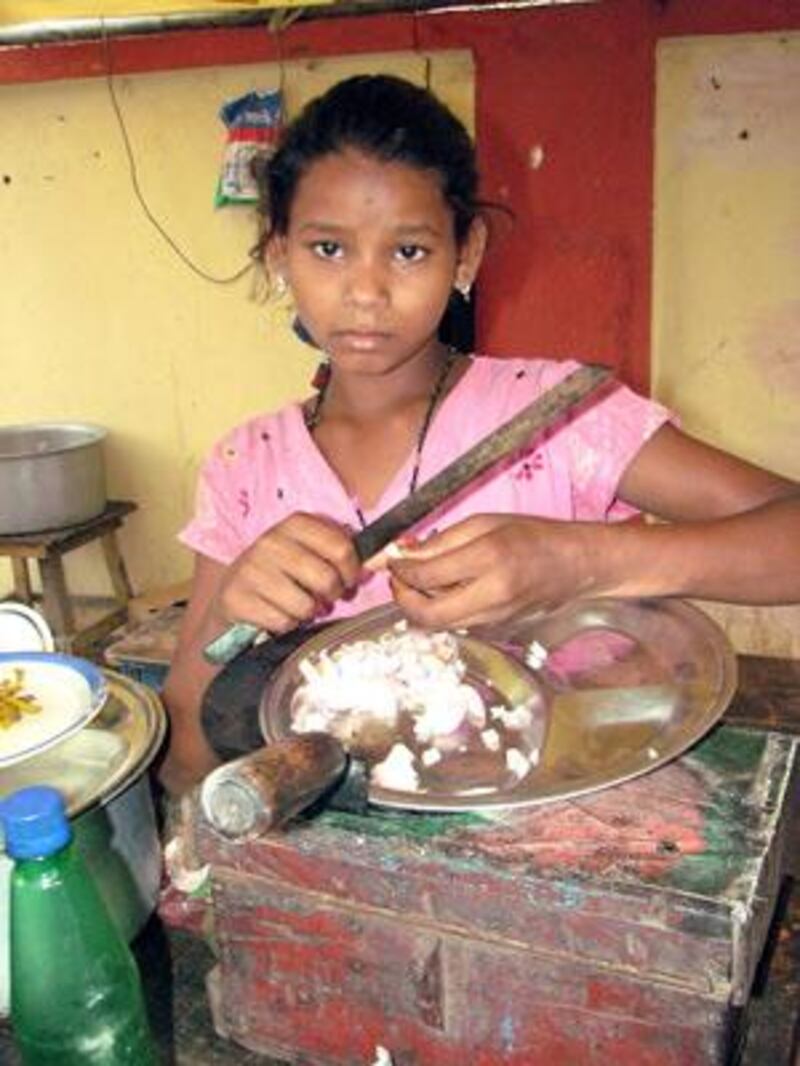PATNA, INDIA // Thirteen-year-old Chunmun Kumari was once the face of Unicef's campaign against child labour in India. Three years later, however, she is still working up to 14 hours a day. Although it is at a roadside tea stall run by her mother in the capital of impoverished Bihar state, Chunmun's fate, like tens of millions of other destitute Indian children, illustrates the failure of the state to enforce child labour laws, advocacy groups say.
Chunmun's mother, Sita Devi, said Unicef and local government officials promised financial assistance and free education to her daughter, but their promises proved hollow. "Initially officials came when her picture appeared on posters across India. They promised help but nothing was given to her, actually, not even any compensation for the picture by Unicef," she said. The Unicef poster in which Chunmun starred proclaims: "No more child labour - this age is for learning and growing, but her daily chores at the stall often keep her away from her studies."
Chunmun aspires to be a teacher, yet at times she spends long hours washing utensils and serving customers tea and snacks at her family's stall. "I help my mother at the stall for 10-12 hours a day. If there is more work at the stall I often miss my school," said Chunmun, a pupil at a government school in Patna. Although the school charges a minimal fee every month, she has to buy books and other study materials, which at times is a huge challenge for the impoverished family. "My monthly school expenditure is 300 rupees (Dh26). The [Bihar] chief minister had promised me free education, books, uniform," Chunmun said.
Chunmun's father, who was the sole breadwinner, died two years ago, leaving the family in deep financial distress. She, along with her seven siblings, started helping her mother round the clock at the stall to sustain themselves. "After my husband's death, it became very difficult to make a living. There was no option left but to make this stall, working again to feed ourselves," said Ms Devi. The family moved to the roadside tea stall to live after selling their shack in a slum to repay debts. "We eat and sleep here, we don't have anything else," she said.
Chunmun became the brand ambassador of Unicef's campaign to eradicate child labour at the age of nine. Her family was proud and they anticipated a secure future for their daughter. "At that time I was sure she would benefit from the campaign," said Ms Devi. Unicef has launched an investigation into the claims made by Chunmun's family. Unicef's India spokeswomen, Angela Walker, said: "There have been reports that Chunmun Kumari is again working as a child labourer. The Bihar government and Unicef are looking into this as part of their commitment and concern to ensure that Chunmun and all children in Bihar can enjoy their right to quality education."
Government and volunteer organisations periodically publicise the plight of millions of children toiling to make a living in India through poster campaigns. Under Indian law, employing or forcing children below the age of 14 into work is unlawful and attracts prison sentences of up to a year and a fine. Almost 35 per cent of India's population are children. Yet the state allocates less than five per cent of its total budget for children's health, education, development and protection.
Millions of children are working in roadside diners, glass factories, carpet looms, agriculture and as domestic help. These children are visible proof that the irrelevance of India's child labour laws as well as the legislation's inbuilt lacunae and the poor child rehabilitation policies. Government figures put the number of child labourers in the country at 12.6 million, but child rights activists say the true number is closer to 60 million. In the past eight years, 670,000 violations under the Child Labour (Prohibition and Regulation) Act have been recorded across India, with 22,588 convictions.
Children's rights groups, unsurprisingly, say the main reason behind child labour is poverty and lack of education. Furthermore, the children are often exploited and forced to work at even lower wages, making them attractive workers for viciously profit-minded employers. Such children are vulnerable not only to economic exploitation but also to sexual abuse. In a country like India - where 40 per cent of people live below the poverty line - poor and helpless parents, in order to ease their burden, are often forced to send their children to work.
"The majority of the population does not have access to the basic necessities of life and live below the poverty line. The problem of child labour is the direct outcome of poverty and unemployment and unless poverty is eradicated from society, the problem of child labour can never be uprooted from society." says Mahesh Jha, the co-ordinator for Bachpan, a child rights group based in Patna. "Long term policies, stringent laws and employment can solve the menace of child labour," he said.
foreign.desk@thenational.ae






